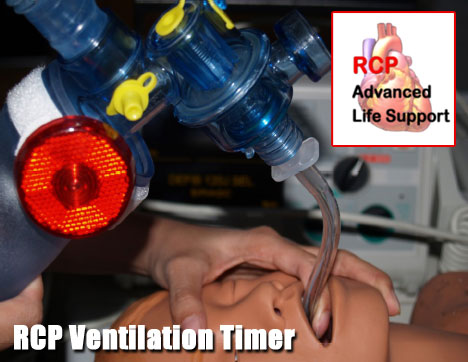
Prompting is the wave of the future. The RCP Ventilation Timer is a low tech solution to a common, deadly problem.
 There are several recent studies documenting poor performance by healthcare providers in several aspects of Cardio Pulmonary Resuscitation (CPR) 1-3. In 5 areas, performance was dramatically lower than current international resuscitation guidelines. The main areas of concern were hyperventilation, rate of compressions, depth of compressions, interruptions in compressions, and incomplete chest wall recoil. Prompting devices along with education significantly improves performance 4-6 and hopefully, survival.
There are several recent studies documenting poor performance by healthcare providers in several aspects of Cardio Pulmonary Resuscitation (CPR) 1-3. In 5 areas, performance was dramatically lower than current international resuscitation guidelines. The main areas of concern were hyperventilation, rate of compressions, depth of compressions, interruptions in compressions, and incomplete chest wall recoil. Prompting devices along with education significantly improves performance 4-6 and hopefully, survival.
Prompting is the wave of the future. It has to be because it improves accuracy. Subjectivity is out when it comes to ventilation rates and compression rates during CPR. We can’t control ourselves when we ventilate or compress somebody in cardiac arrest. Subjectivity is prone to error. How do you know you’re compressing at 100 compressions per minute or ventilating at 8-10 bpm? The answer is you don’t.
One person’s 100 compressions per minute might be significantly slower or faster than another’s. Our self-perceived 10 breaths per minute might actually be 30-40 breaths per minute (bpm) etc... These slight variations during CPR are potentially deadly. I’m sure you’ve seen a cardiac arrest where the patient received suboptimal CPR. Is this ethical?
If we have the technology to improve accuracy in CPR then we must use it. The use of prompting devices removes rate subjectivity and improves accuracy during CPR 6-7.
A few defibrillators have built in CPR prompt devices that tell you to increase your rate of compressions, or to push harder if your compressions aren’t deep enough9. These devices improve CPR accuracy. Unfortunately, the cost of these new defibrillators is prohibitive for many hospitals.
Hyperventilation during CPR
An excessive respiratory rate increases intrathoracic pressure. This pressure reduces coronary perfusion and blood flow which is already very low. Think about it this way. If you put positive pressure on the outside of any vessel that pressure will compress the vessel and lower blood flow. Blood flow to the heart muscle (coronary perfusion/blood flow) is critical to survival. How can a heart that is not perfused beat again? In most situations it can’t. This is one reason why our general survival rates are so low. The RCP Ventilation Timing Device is an inexpensive, low tech solution to this common and deadly problem.
- This is an excellent training aid for CPR, ACLS or PALS training centers to let students see their actual rate compared to the recommended rate
- All critical care and other areas where CPR is to be provided. (ICU, ER, all crash carts etc…)
- Hospital education
- Prehospital education
- Formal education centers like Nursing, RT, Paramedic, PA, DO, and Medical schools etc…
- During transport
- Turn on timer to appropriate rate for situation (8 bpm during cardiac arrest or 12 bpm for post resuscitation care.
- Verify function of the timer. The light should flash approximately every seven seconds.
- Place timer in line of sight. Wrap strap around ventilation bag, wrist, IV pole, defibrillator handle or other easily visible place
- If using the clip, attach the timer to the bag ( pinch the bag at the site you want to attach and attach directly to the bag) or attach to your lab coat or watch in your line of sight
- Ventilate patient every time the light flashes.
- Avoid contact with body fluids.
- Replace strap or device as needed.
- Mount light close to patient advanced airway so you can see both at the same time.
- Secure advanced airway when using this device.
- If patient is intubated and in cardiac arrest (the rate should be set to 8 bpm), ventilate whenever the light flashes ( try and coordinate with the release phase of a compression )
- If patient is intubated and is post resuscitation with a pulse, initially ventilate at a rate of 12 bpm and then use ABG’s to guide treatment.
- During post resuscitation transport, if ventilator rate is 8 or 12 you may use this light as a transport timer
- Turn off light when finished and wipe product with rubbing alcohol if soiled or replace device is grossly contaminated.
- Rate will not become slower when batteries are low. The light will just be dimmer. Replace batteries about every 4 months, when dim or replace with a new device.
- Uses replacement battery # 357
The RCP Ventilation timer is an excellent training center adjunct. Help your students master the tempo of correct ventilation rate.
We use the timer to demonstrate accurate ventilation rates during CPR and post resuscitation care.
Disclaimer: Use this product with caution. This product is not designed to replace clinical judgment. Some situations might warrant increased respiratory rates. Always ventilate according to the most current, basic and advanced life support guidelines with appropriate medical direction.
If product is soiled wipe with alcohol and replace strap. Do not let timer come in contact with bodily fluids. Always seek expert consultation and medical direction if there are any doubts about using this device. These instructions do not replace or alter hospital policy and procedures.
RCPALS SHALL NOT BE HELD LIABLE FOR INCIDENTAL, CONSEQUENTIAL, INDIRECT OR SPECIAL DAMAGES OF ANY KIND; OR FOR LOSS OF REVENUE, LOSS OF BUSINESS OR OTHER FINANCIAL LOSS ARISING OUT OF, OR IN CONNECTION WITH THE SALE, OPERATION, MAINTENANCE, USE, PERFORMANCE, OR FAILURE, OF ITS PRODUCTS.
RCPALS warrants its products to be free from defects in material and workmanship, under normal use and service, for twelve months from the date of purchase from RCPALS or its authorized agents.
This warranty does not cover the product if it is damaged by abuse, accident, misuse, improper operation. If a product does not operate as warranted during the applicable warranty period, RCPALS shall, at its option and expense, deliver to the customer an equivalent product to replace the defective item.720 N Valley St. Suite F Anaheim, California 92801
Website: www.rcpals.com